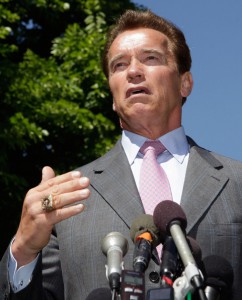
Less than one month after ending furloughs for about 200,000 state workers, Gov. Arnold Schwarzenegger this morning brought back a scaled-down version of the policy, effective Sunday.
The governor made the decision this week after Controller John Chiang said that unless lawmakers enacted a budget soon, the state’s cash would go into the red by October. Chiang said he’ll start issuing IOUs in August or September to conserve funds as long as possible.
“We have a fiscal crisis,” Schwarzenegger spokesman Aaron McLear said this morning as he explained the new furlough order. “We’re doing what we have to do to conserve cash.”
Like the policy that ended June 30, the governor’s new executive order requires employees take three unpaid days off per month. But unlike that policy, it has no termination date: Furloughs will end when lawmakers pass a 2010-11 budget. That could be weeks or months after the Legislature reconvenes on Monday.
And unlike earlier policies, the new order exempts employees who work for departments that collect revenue, such as the 5,000 staff at the Franchise Tax Board. Staff in “special fund” organizations that receive considerable money from sources other than the general fund are also left untouched.
McLear said that the administration couldn’t exclude those employees previously because the state faced twin revenue and cash crunches.
“Last year we were in free-fall,” he said, but now the revenue crunch has eased, which allows the state some furlough flexibility.
Today’s order also excludes about 37,000 state workers in six unions that recently reached tentative labor agreements with the Schwarzenegger administration.
“We expect the Legislature to quickly ratify those contracts next week,” McLear said.
Those deals contain concessions, including monthly furlough days and higher out-of-pocket employee pension contributions, that save the state money and make furloughing those employees unnecessary, McLear said.
As part of the agreements, the administration promised that the Legislature will enact measures that will protect those employees from furloughs, minimum wage or both.
“We keep our promises to the unions,” McLear said.
Another six unions representing about 150,000 state employees, including the 95,000-member SEIU Local 1000, haven’t yet come to labor terms with the governor.
Managers and supervisors make up the remainder of the workforce. Unless they work in an exempted department, they are subject to the furlough order.
Bruce Blanning, head of the 11,000-member Professional Engineers In California Government, said that the move is really designed to squeeze unions like his that haven’t cut similar deals.
“It’s more misguided pressure from the governor on those who won’t agree with his program,” Blanning said.
Today’s order marks the third time that Schwarzenegger has unilaterally reduced state workers’ hours and pay. In December 2008, with the state mired in a severe fiscal crisis, he directed that state workers take off two unpaid days per month.
Several state employee unions sued to block the order, but a Sacramento court in January 2009 agreed with Schwarzenegger that the crisis was an “emergency” that allowed the governor to mandate furloughs to address it. Twice-monthly furlough days started the next month for most of California’s 235,000 or so state workers hired through the executive branch.
In June of 2009, Schwarzenegger added a third furlough day each month for the 2009-10 fiscal year that started July 1, 2009 and ended June 30. The Legislature passed a budget that assumed the savings.
Although lawmakers failed to pass a budget last month, the governor ended furloughs as planned. Since then, the administration has tried — and so far failed — to withhold state workers’ pay to federal minimum wage during the budget impasse, all the while warning that every day the state goes without a budget would make furloughs or layoffs more likely.
In total, state workers have lost 46 days of wages to furloughs in the last 17 months. One furlough day equals 4.65 percent of an employee’s pay. A single furlough day reduces the state’s payroll cost by about $61 million, or $2.2 billion for the 2010-11 fiscal year. About half of that is from the state’s general fund, which is the cash-strapped center of California’s rolling budget crises.
Schwarzenegger has exempted a few groups, however. About 11,000 Highway Patrol officers and firefighters have never been furloughed and are again excluded this time around. The administration has said that those jobs are too vital to pare down.
Another 16,000 employees who work for officials in statewide offices such as the treasurer, secretary of state and the controller have also avoided furloughs. The heads of those departments say that their independence gives them the authority to manage their own employees. All have made other cuts — in some cases asking employees to volunteer for furloughs — rather than comply with Schwarzenegger’s order.
That furlough dispute and others have triggered about 30 lawsuits over the last 19 months. About a half-dozen cases are now before the state Supreme Court, which won’t hear arguments until September at the earliest.